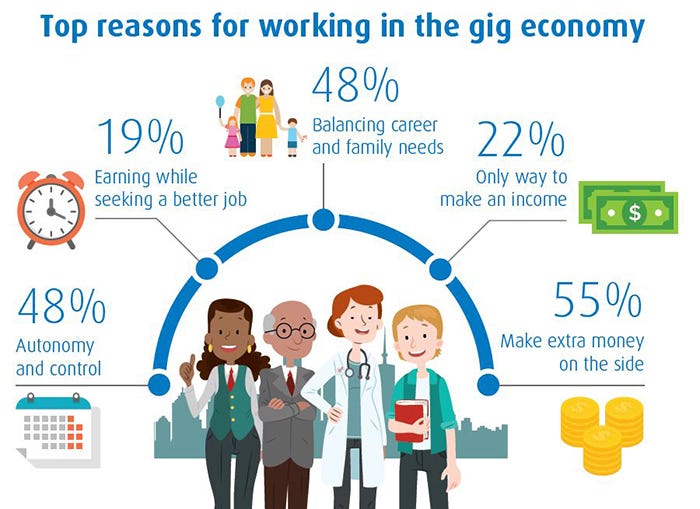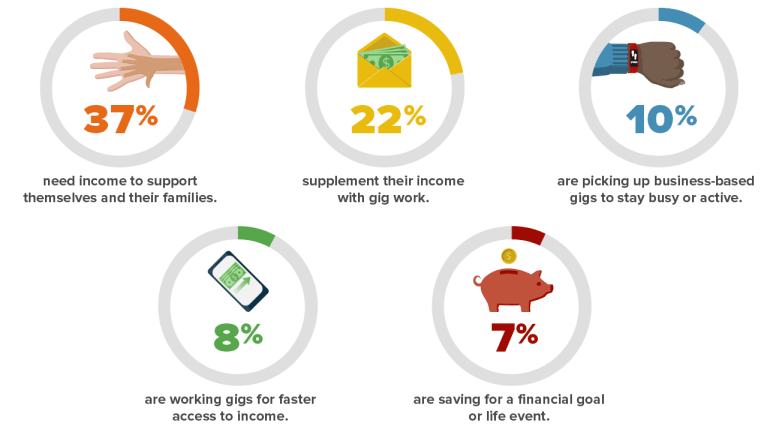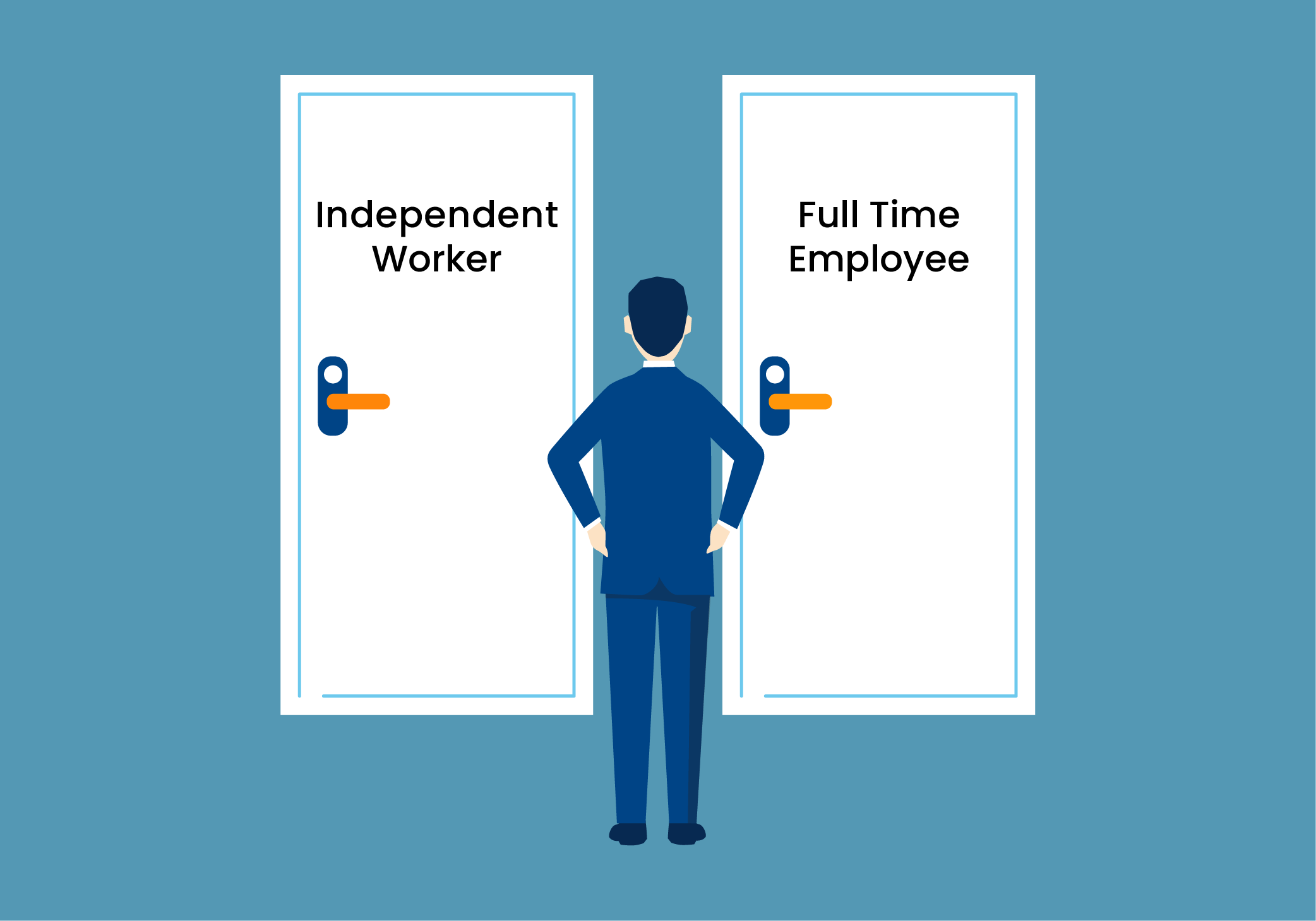The gig economy is a labor market with a strong emphasis on short-term, freelance, and contract jobs completed by people working as individual operators, as opposed to full-time employees. As such, the gig economy includes gig workers as freelancers, contractors, side hustlers, and anyone who’s making money on the side or earning full-time income with various short-term projects, rather than a single full-time job.
Gig workers can also be rideshare and delivery drivers, handymen, grocery shoppers, graphic designers, writers, developers, and more. The term “gig economy” refers to a workforce that’s defined by short-term engagements, temporary contract work, and independent contracting.
The seemingly new buzzword ‘gig’ is booming. According to a 2018 report by Edison Research, of the 1,044 Americans surveyed, nearly a quarter made money in the gig economy. And of those, 44% relied on gigs as their primary income. Gig workers tend to be young, with 38% being 18 to 34 years old. In fact, the Bureau of Labor Statistics found that 5.9 million people held “contingent jobs” in May of 2017, which represents 3.8% of all workers in the U.S. A career transition is a perfect time to jump and test the waters because you are likely to have more time on your hands and less income coming in.
Benefits of the gig workers:
- Empowerment of being your own boss and choosing work that interests you
- Potential to make more money depending on your skills
- The flexibility of the gig economy allows beyond the traditional 9-to-5 and getting the right work-life blend
- Autonomy (being able to work from anywhere)
- Other perks in the form of job security, stable salary
- An environment with smart people who can potentially push their careers forward
- Multiple jobs can be taken at a time
Drawbacks of the gig workers:
- Struggle to bring in steady, reliable income
- Cannot expect a paycheck every two weeks
- Lack of stability can take a toll on your mental health and job security
- Gig workers’ earnings can suffer during a pandemic
- More workers competing for each gig that came through, driving wages down
- No benefits that come with traditional employment, such as health insurance, stock options
Here are some tips to switch from a gig workers to a full-time jewellery professional:
Start with something you specialize in as gig workers
People hire gig workers or freelancers for a few reasons, one of them is that they specialize in something. Companies don’t want to fully train you like they would a new staff member in jewellery industry, which takes time and money. Rather, they want to bring in someone who can get the work done with whatever project-based direction they have to give.
Use your recent freelance skills as gig workers to your advantage
As a gig worker, you are a project manager, an accountant, a business analyst, an expert in communication and so many other things. Because you run your own business, you’ve learned a lot of skills that a lot of other full-time employees don’t have, whether you know it or not. As you’re looking for a full-time job in jewellery industry, don’t be afraid of the varied job descriptions. You can prove that you’re a fast learner and that you are able to perform successfully in many unique business environments.
There are a number of companies out there that thrive on flexible and agile team members. Startups, for example, provide excellent transition roles for gig workers or a freelancer. Working for a startup means that you need to pivot and learn new skills. You’ll likely have to take on new responsibilities and set aside something else to reach new goals. Small companies and agencies thrive off flexible team members as well.
For example, I’ve freelanced and worked full-time at agencies in the past. I was a valuable asset to them because I was able to help with a lot of different tasks.
Be patient while transitioning from being gig workers to full-time positions
The fact is that some hiring managers are looking for a specific type of candidate. They are looking for someone who has come from an “x” company with “y” experience. As gig workers often aren’t that cut-and-dry type of cookie-cutter person, it might create a unique scenario. During the interview process, you’ll have a lot to talk about! Make sure to discuss that your freelancing is not an employment gap. You can bring up how you’ve helped a company reach a particular milestone.
Consider changing your strategy and applying to a different set of companies. We list a helpful list of remote job boards here, many of which are for diverse skill sets. We’re curating a community of motivated individuals who want to work remotely. Sign up for our community (it’s free!) and we’ll start pairing you with companies that are looking for talented professionals.
Have a prepared reason for why you’re a gig worker looking for full-time work
It will likely come up multiple times: “So, why did you decide to look for a full-time job?” Your answer will be a personal one but should show confidence in your decision. You don’t want to say, “I couldn’t find any clients,” or, “It was too hard.” It’s better to say something like, “I’m looking for my next challenge,” or, “I want to apply my abilities to a bigger cause.” Remember that as a freelancer, you own/owned a business. It’s easy to get into a routine and forget that as a freelancer, you currently own a business!
Be prepared to focus on one particular skill set for a full-time role
After working in a freelance capacity, it’s no secret that you’ve picked up a number of new and exciting skills. It’s not like you’re not grateful for those skills and experiences, but they’re sometimes not completely necessary in being able to be effective in your new jobs. However, I can use the themes of those unneeded skills to my advantage. Instead of being able to hold a client accountable for changes being in scope, I can set better expectations for my coworkers and team members.
Make yourself visible even while you are being a gig worker
If you’re new to the side hustle game, you have to start building relationships. One way to do that is to create profiles on various job websites. This is the best way to find work both actively and passively. Actively, you can be searching for gigs that fit your skillset, just like you would with regular job searching. On the other hand, with a good profile in place, you’ll be able to passively find work because those looking to fill positions can find you.
Network with people who are working for companies full-time
If you’re finding it difficult to hear back from companies that you’re applying to, network with people who work for companies that you’d like to work for. Sometimes all it takes is one positive referral to bypass into the next level of the interview process. Even if you’re not transitioning from freelance back to full-time, first-hand referrals are some of the best ways to find a new job. You can even reach out to some of your existing freelance clients and tell them that you are interested in working full-time somewhere.
Don’t abandon all of your gigs work clients and connections
In the same way, you’d leave a full-time job, you should leave a long-term freelance relationship gracefully and respectfully. It’s common courtesy to give ample time for your notice. This way, if you hold a lot of knowledge, you can spend the time to train someone else, or leave breadcrumbs with the work that you’ve been doing.
Getting into Jewelry Design
Getting into a jewelry design can be an exciting and rewarding path. It requires creativity, attention to detail, and a passion for aesthetics. A formal education in jewelry design or a related field is helpful, as it provides the necessary skills and knowledge. Building a strong portfolio and networking with industry professionals can also open doors to opportunities in this competitive field.
Final Thoughts
Transitioning from being a gig worker to becoming a jewellery professional requires careful planning and dedication. By following these tips, you can pave the way for a successful career shift in the jewellery industry:
- Acquire relevant skills: Invest in jewellery design and craftsmanship courses to develop your technical expertise.
- Build a portfolio: Create a portfolio showcasing your unique designs and craftsmanship to attract potential clients or employers.
- Network with industry professionals: Attend jewellery trade shows, join online communities, and connect with established professionals to expand your network.
- Gain practical experience: Seek internships or apprenticeships with reputable jewellers to gain hands-on experience and learn industry best practices.
- Establish your brand: Develop a distinct style and create an online presence through a website or social media platforms to showcase your work.
- Market yourself: Utilize marketing strategies such as attending trade fairs, collaborating with influencers, and leveraging social media platforms to promote your skills and services.
By following these tips, you can successfully transition from being a gig worker to a respected jewellery professional, opening doors to a rewarding and fulfilling career in the industry.








